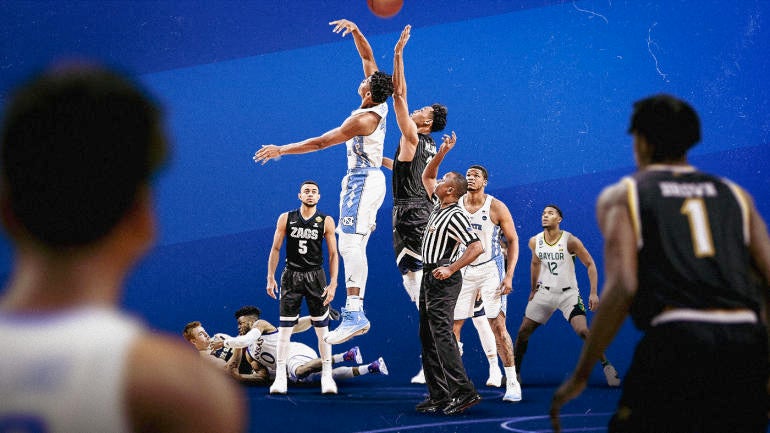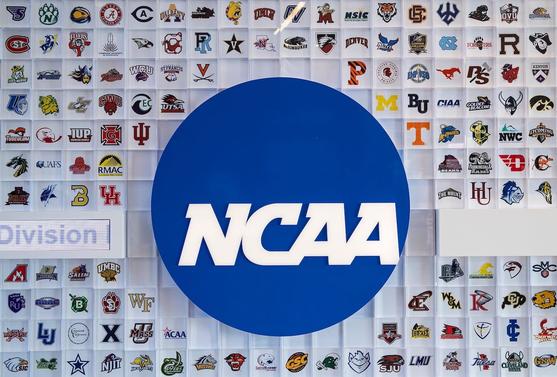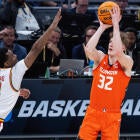
CBS Sports' Gary Parrish and Matt Norlander surveyed roughly 100 coaches for our annual Candid Coaches series. They polled everyone from head coaches at elite programs to assistants at small Division I schools. In exchange for complete anonymity, these coaches provided unfiltered honesty about a number of topics. This is our final week of posting the results of our summer survey on the state of college basketball.
Our Candid Coaches poll question from Monday addressed the looming curiosity over whether the NCAA Tournament might face any tweaks or remodels in the coming years. The only reason the controversial topic is potentially up for debate is due to the existence of the NCAA Division I Transformation Committee, which was formed in 2021 to help modernize college athletics.
Among the litany of actions that committee has been tasked with, the biggest in scope is redefining what it means to be a Division I institution and/or deciding if Division I will be tiered out into subgroups based upon university resources, spending budgets, conference affiliations and other to-be-determined factors. College basketball is the biggest elephant in that room. The sport's roster of teams has bloated yet again, increasing to 363 for the 2022-23 season, up five from a year ago. No American sport has more teams under one umbrella than D-I college basketball; it's 726 when accounting for men's and women's. Twenty-five years ago, Division I basketball had nearly 60 fewer schools.
When does it stop? Is it already too big, or can the sport support this many teams? Should the transformation committee splinter Division I up into two, maybe even three subdivisions? That's today's Candid Coaches poll question.
How big should Division I basketball be?
| Stay at current size | 53.7% |
| Cut by 15-20% | 26.3% |
| Cut by ~40% | 12.6% |
| Cut by 50% or more | 7.4% |
Quotes that stood out
Stay at 363/keep D-I same size
• "It is the ONLY sport where every college participates. All D-I teams have men's and women's basketball. If you meet the qualifications to qualify as D-I, the more the merrier in my opinion."
• "I'm torn between leaving it as is and cutting it down by 75-80 teams. Don't really see the harm in just leaving it as is. I do think some universities put more strain on themselves trying to compete at this level than what they benefit from it. I again go back to Saint Peter's of this year, UMBC from a few years ago. Do these teams make it above the cutline? Their stories are just as important to the college basketball brand as your traditional bluebloods' dominance."
• "Leave the current number of D-I teams alone, but mandate a baseline of investment into the sports they sponsor. This will force schools to make real decisions and not just be D-I in name only."
• "I think the thing that makes college basketball great is all the teams in the same classification. If Washington football played at Colgate ... it's a different perception. It will never happen in football but it does happen in basketball and that's what makes college basketball better than college football. They better not mess with that, because that's what Sankey's messing with. For money."
• "If you're going to cut it, cut 10%. I like the model like it is though. Saint Peter's, man. That's a beautiful thing. There are some teams in low-major divisions that have been the bottom-feeders and have consistently been the bottom-feeder. I get cutting those teams. But I don't want to see the mid-majors leave."
Cut by 15-20%
• "I think that the NCAA should take a serious look at the financial fitness of many D-I schools, both athletic departments and university enrollment/endowments. I can go way too deep in my opinions on this topic, so I'll just say this: I have coached now at the D-I, D-II and D-III levels in my career, and in my opinion there are many D-II and D-III programs that far outclass some of the low D-I programs that I have seen. I'm talking across the board -- from administration, organization, game-day structure, scheduling, contracts, etc. I could go on. It's my opinion that trimming the fat would be a good thing for the game."
• "I am not sure how many need to be moved down to another classification, but I am positive that some don't belong merely because of the differences in budgets. While it used to make sense, it doesn't anymore. There are simply not enough reasons that some schools should be grouped with others. NCAA college basketball is a one-of-a-kind entity when it comes to basketball within the international space. This is why student-athletes from all across the world have flocked to the United States to participate. With all of the uncertainty regarding NIL and the transfer portal, we are definitely at a crossroads in what NCAA college basketball at all levels could look like in the future."
Cut by ~40% (approx. 150 teams)
• "I'd say cut the bottom third. I hate coaching in those crappy games, let alone if I had to actually play in them. I am sure a lot of coaches like them because they are easy wins and they can pad their record, but I find it to be a complete waste of everyone's time when a high-major team and a 250-plus KenPom team play a 40-point blowout."
• "I love mid-major basketball. The good programs are really good, but the bottom of those leagues just aren't serious about basketball and it hurts the good mids come Selection Sunday."
• "My number is about 250 teams to make it as good as possible. I think what's happening is there's a lot of watering down and schools that are in it, but not really in it. I've been in those leagues. They don't really fund it. I was on the phone with one coach and they can't afford a roll of toilet paper in their locker room. What are we doing here? It would get rid of some of those places that you just don't have the money and I think it would strengthen the quality of players."
• "I think Division I will be divided into three subgroups: 1A, which is [Power Six], will have stipends and utilize autonomy. 1B will look like college now with some NIL. 1C will be anchored by the Ivy league, Patriot League and their presidents trying to maintain traditional academic model."
Cut by 50% or more
• "Two divisions: Top 150-175 and the others. Have to meet certain criteria as it relates to wins, money spent, commitment to stay in top division."
• "I'm a little conflicted. A part of me thinks if you cut out half the teams in college basketball and basically have all the mid-major-plus to high-major programs at the highest level having to playing against each other each night, it creates a better basketball schedule and environment. None of those 40-point nonconference blowouts. But the other part of me thinks it would take away from the overall experience and the potential NCAA Tournament with Cinderella. I can see value in both."
• "Football's more in a position I'm talking about already where they've already separated themselves. College basketball hasn't. Looking at us (a mid-major program), we're so much more equipped than the bottom 100. You look at the bottom 100, you say there's no way this is D-I, whether it's meals, resources, everything. How are they supposed to compete with schools that can provide players an extra $50,000 year?"

The takeaway
There is no need for any more teams in Division I basketball. Let's start there. Whether or not you think the inventory should be slashed, it's exceeded its capacity in the past 10-15 years.
Is the product being helped by how big it is? I would argue it's not, certainly not in the regular season, which is where the sport needs as much juice, competitiveness and relevancy as it can muster. The more teams you add, the higher the number of Quad 3 and Quad 4 games will populate the schedule. That's just filler. Empty calories. The worse it is for basketball overall, the more it waters down NCAA Tournament résumés. As I wrote recently in my pre-preseason 2022-23 preview: lock the door. No more schools in.
I surmise the ideal number for D-I is probably about 300 teams, and I wouldn't object to making it a bit smaller than that. At that size you could get everything you want out of a schedule (buy games included) and still have the NCAA and NIT tournaments in their current forms without changing a thing.
Question is, will the transformation committee reshape D-I basketball as we know it? It's realistic to project Division I being reorganized in the coming half-decade. If that happens, I think that's how the NCAA Tournament could see its qualification standards be impacted. It's a way to manipulate having X-fewer-number of teams from smaller conferences included in the Dance.
A workaround disguised as a policy change.
The barrier to entry for some teams and conferences could shift -- becoming even more difficult -- if a reclassification of what it means to be a Division I basketball institution is determined by athletic budgets, historical and/or recent success, and more.
The big-picture question is how such a reorganization takes place and what a new Division I would look like. (Let alone how postseason money would be split, the biggest matter of all.)
Would all these teams remain in D-I in an official capacity, albeit with the crucial caveat that there would be two or three tiers? Would those tiers all still count toward building NCAA Tournament résumés? If you move some teams down in classification, wouldn't they no longer statistically qualify as D-I in the NET and other metrics? If not, then what's the point?
There are major consequences to this kind of NCAA cartography. Feelings stand to be hurt, sports are vulnerable to being cut, athletic departments in one-bid leagues could face devastating times.
I don't think any school will be kicked out of Division I inasmuch that I think there's potential for 120-200 schools that could be automatically elevated to the highest tier. What that would be called, who knows?
"A legitimate issue that at some point is going to have to be dealt with," one coach told me. "It's going to come back to money, of course, and all that's out there. There's also the talk of reducing the number of sports that you have to sponsor to be Division I, which is going to maybe weed some people out too."
Another problem with a potential reshaping is how you handle conference structure. Gonzaga in the (shrinking) WCC is an exception (should it remain in that league) to the idea that any and all conferences could be put into different buckets. There are great mid-major basketball leagues, such as the Missouri Valley and SoCon, and they've proven to be viable for a long time. Those leagues and many of the teams in them have no business being downgraded below the likes of the A-10, Mountain West or the American.
There's not an ideal or simple way to draw lines and declare, "These leagues are top tier, these are mid-tier, these are lowest tier." Division I basketball has a viscosity to it that keeps many of its conferences in a state of flux. The CAA ranked 14th last season at KenPom. Four years ago it was 22nd, and that was two years removed from it being 12th. Similar rankings ricochets are true of the Ivy League, the MAAC, the Big West and more.
This is a big issue and a touchy subject. No one wants to be demoted. If anything, I was surprised more coaches didn't vote to keep D-I the same size. That 53.7% is a good number, but consider the inverse: 46.3% of coaches we polled believe D-I basketball has too many teams. The coaching community is close to split on this issue.
There will be a fight to keep D-I basketball as big as it's ever been, but actually scanning the landscape and assessing the value of having a sport this populated, with 363 teams in 49 states, is an overdue endeavor. The transformation committee has no bigger duty on its hands than redrawing the lines of what it means to be Division I.
If this leads to potential relegation/promotion of tiers within a D-I configuration, a la European soccer, then I think the idea has merit and upside. I just don't see college sports leaders having the guts to be that bold.
![[object Object] Logo](https://sportshub.cbsistatic.com/i/2020/04/22/e9ceb731-8b3f-4c60-98fe-090ab66a2997/screen-shot-2020-04-22-at-11-04-56-am.png)


















